How to prove the value of your PR strategy to your CEO Talkwalker
When it comes to your PR strategy, how do you justify to your CEO? You need them, and their finances, on side, but using the right analytics ...
March 6, 2018
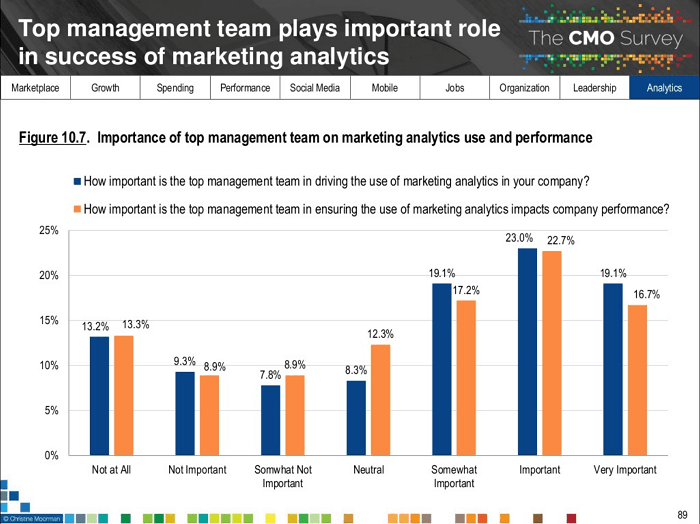
PR is about your reputation. It is key to your brand’s success. Yet demonstrating how that reputation impacts on your company’s goals is hard work. Especially when compared to marketing, whose KPIs are closely tied to business demands.
So when it comes to discussing PR with your CEO, you have to prove how important a successful public relations strategy is to your company.
Here’s how...
Request a free demo of Talkwalker Analytics
Understand your CEO
Your CEO has a lot on their shoulders, responsible for the success of your company, and the livelihoods of hundreds or thousands of employees.
They focus on brand reputation & integrity, and consider how broader societal threats could impact on the company as a whole. In PwC’s 21st CEO Survey, over-regulation, terrorism, and geopolitical uncertainty were the top 3 concerns for CEOs.
Everything a CEO does must be justifiable, to themselves, and to the board. You have to provide that justification.
Analytics are essential here. 61.2% of those surveyed in the February 2018 CMO Survey stated top management are at least somewhat important in driving the use of marketing analytics.
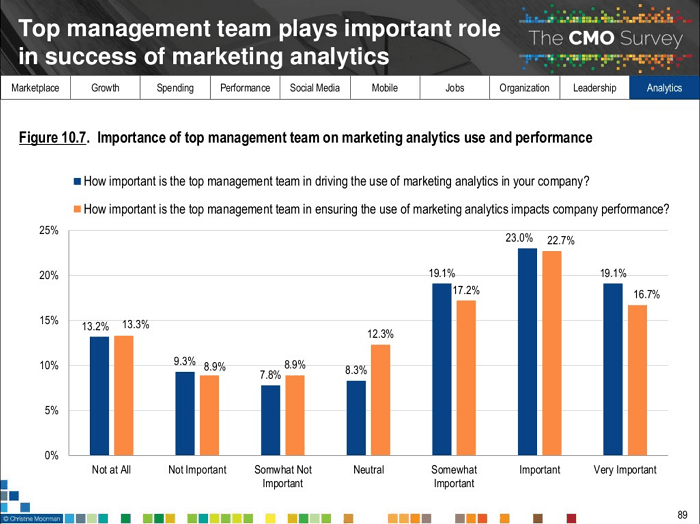
And yet, according to BCG, many CMOs worry about whether they are making decisions based on analytical data.
To get your CEO on side, you have to provide them with the analytical data needed to prove success.
“Don’t speak about PR metrics. Shift the conversation toward business discussions and insights and have the data to back your counsel. Insight is the new currency and the key to the C-Suite.”Andrew Bowins, Executive Director, Corporate Reputation and Digital Engagement, KPMG LLP
How not to justify your PR strategy
The old (wrong) way to measure the impact of your Public Relations strategy, was to use AVEs. Yet, the CIPR has pledged to ban them, and we’ve already discussed why advertising value equivalency doesn’t work for measuring your PR value.
AVEs aren’t the metrics you need.
Neither are some of the more traditional measurements you may have used in the past.
These include metrics such as:
Coverage volume.
Potential reach.
Earned impressions.
Earned engagement.
They’re useful for measuring the effects of your PR efforts, but they don’t show any value to your CEO.
“We must keep striving to measure impact and outcome whenever possible. Not only because impact and outcome prove value but also because they are the gold-standard measures used by advertising, media buying, and digital agencies.”Brian Keenan, VP Planning, Weber Shandwick
Before you add anything to your strategy, even if requested by your C-suite, Kim Harrison (Cutting Edge PR) suggests assessing how valuable those actions would be to your company (and your CEO).
Ask yourself:
Does this activity connect to our overall goals?
What value will the business gain if this activity succeeds?
How do we measure the results?
Goalposts can move
Don’t forget, when developing a PR strategy that supports your business goals, those goals can change. Try to understand what your company requires from you this year, and for the next five to ten years, to ensure you can adapt your strategy and remain in line.
SSPR suggests revisiting your goals regularly, so you can see where your PR and business efforts are coordinating, and help you avoid unexpected CEO questions about your strategy’s impact.
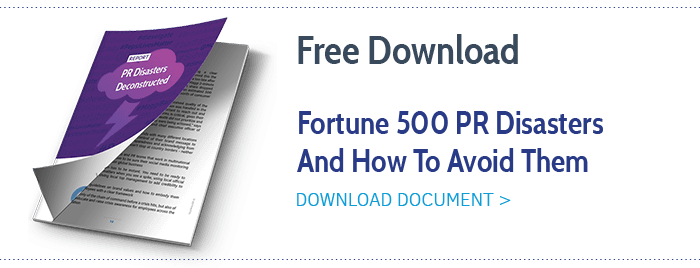
Align your PR strategy goals with marketing
If you can’t beat them, join them.
According to the Global Communications report 2017, 47% of in-house PR professionals believe PR will become more closely aligned with marketing in the future.
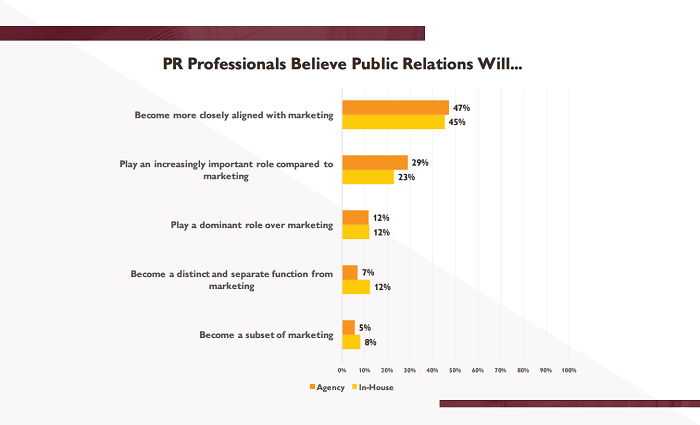
You can see why. Marketing often has more targeted KPIs, that run parallel to business goals. By aligning your PR plans alongside theirs, you can show integration with the company’s needs.
And there are additional benefits to collaborating your strategies. By developing integrated campaigns, you can create content that engages media coverage, and then use on social media or blogs to gather readers. That reduces the workload across the teams while ensuring maximum output. That can only be beneficial to both departments.
How to accurately measure your impact
At this point, you should know what you CEO’s (and company’s) goals are, and how they match with your PR goals. Plus, you’ve started working closer with marketing.
The next step is proving your strategy works with value-driven PR metrics.
The importance of benchmarks
Benchmarks are the measurement method to use when writing a PR strategy. At all times, you should have an idea of the results your business drives day to day, and the kind of results your competitors drive too. Setting benchmarks based on this typical PR traction, will help you see the impact your PR campaign makes.
The difficulty is deciding which metrics are important to your role, and which ones have business impact.
_“In order to be able to provide value to the C-suite, PR professionals must be able to tie in key metrics that have a direct impact on both communication and business objectives. Without the connection, senior management will not be able to demonstrate the impact of the work being done by the PR and social teams.It is key to explore advanced metrics like: Return on Connection (as recommended by Deirdre Breakenridge), Influencer Impact, Emerging Community Trends in Network, Reputation Impact, Health of Community and Network, and Conversion rate.”_Dr. Karen Freberg, Ph.D. Social Media Professor
For accurate PR measurement, here are a few examples of benchmarks you need:
Change in sentiment
Sentiment has a positive impact on sales and consumer advocacy, as well as helping identify patterns in consumer behavior. This offers you more detailed targeting opportunities.
By using sentiment analysis pre- and post-campaign to calculate the consumer sentiment variance, you can demonstrate the impact your campaign had on your target audience.
You can also look at the net sentiment surrounding key brand attributes, to access how your consumers are engaging with the business messages you’re diffusing.
A high street retailer may want to be known as affordable, on-trend and customer focused. By analyzing the sentiment surrounding mentions of those attributes, and comparing the change, the brand can see how those key messages are diffusing into their consumer mindset.
Share of voice
The Millward Brown report, Are you getting your fair digital share? demonstrated how share of digital voice directly impacts on your market share growth.
If your CEO focuses on business growth, this is a metric that you need to monitor consistently.
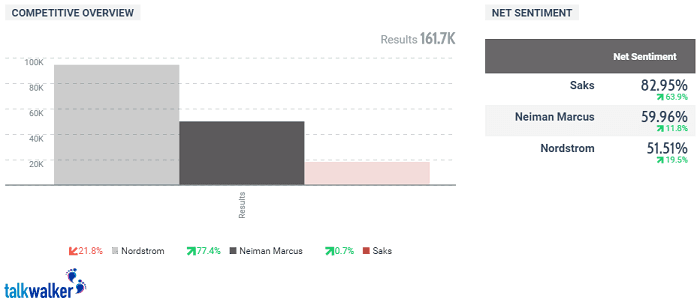
Ensure you include sentiment alongside your share of voice. In this case, Nordstrom has a better share of voice, but significantly more of those mentions are negative than those of Saks.
Insights and trends analysis
Andrew Bowins believes the most useful metric communicators can bring to the C-suite to prove the best PR strategies, is insights and trends analysis.
“First you have to organize and collect the data. That is easy these days. The hard part is shaping your metrics into a story that is relevant to a business leader and unlocking insights and trends that allow you to teach. If you have the insights, leaders will listen and ask for more.”Andrew Bowins, Executive Director, Corporate Reputation and Digital Engagement, KPMG LLP
Communicate PR strategy successes (and failures)
The final thing you need to do to win over your CEO is to report to them about your PR strategy results. Whether good or bad.
Remember, when reporting to CEOs, time and clarity is of the essence. Support your results with accurate analytics to show tangible results, and ensure you tie those results back to your business goals.
They don’t want to see a win for PR. They want to see a win for the company.
Engage them in your strategy by clarifying what’s next, whether that’s another stage to continue your brand success or a change of strategy to counteract a recent failure.
Verify your ROI
Another way to justify your success, is to validate the ROI of your campaign. The cost/profit ratio is always an underlying factor to a CEO’s plans, so by justifying your work in financial figures, they’ll learn to appreciate your strategy for PR more.
Ultimately, you want to demonstrate how your campaign has affected the company as a whole. This comes down to how much money it brought in. By calculating your campaign’s ROI, you can justify how much value your PR adds. Spin Sucks offers a concise way to measure your PR ROI.
“If you can prove your communications efforts generated X number of leads, which turned into X number of customers, you suddenly have your PR ROI.”Gini Dietrich, CEO of Arment Dietrich, and founder & author of Spin Sucks.
Conclusion
You know an effective PR strategy is important. Not just to your department, but to your business, and your CEO.
Your mission is to prove how important that PR methodology is. And that comes down to the skills of today’s modern PR strategists.
“Next to doing the right thing, is to let people know you are doing the right thing.”John D. Rockefeller, business magnate
Now we’ve given you some inspiration on how to get your CEO onboard, get measuring those analytics, and get the proof you need. Request a free demo below, to see how Talkwalker can measure the important metrics. Or drop us a comment below if you have any tips on how to win over your CEO.

